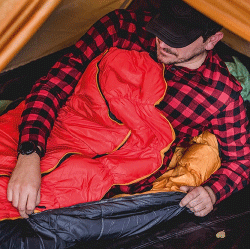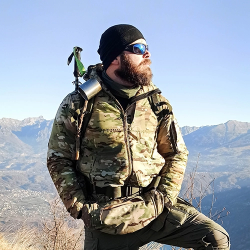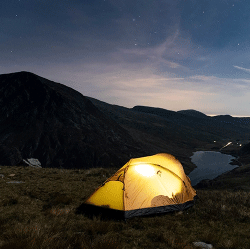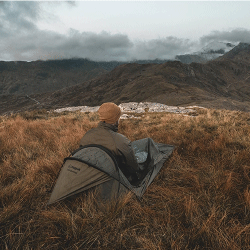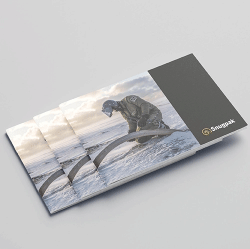
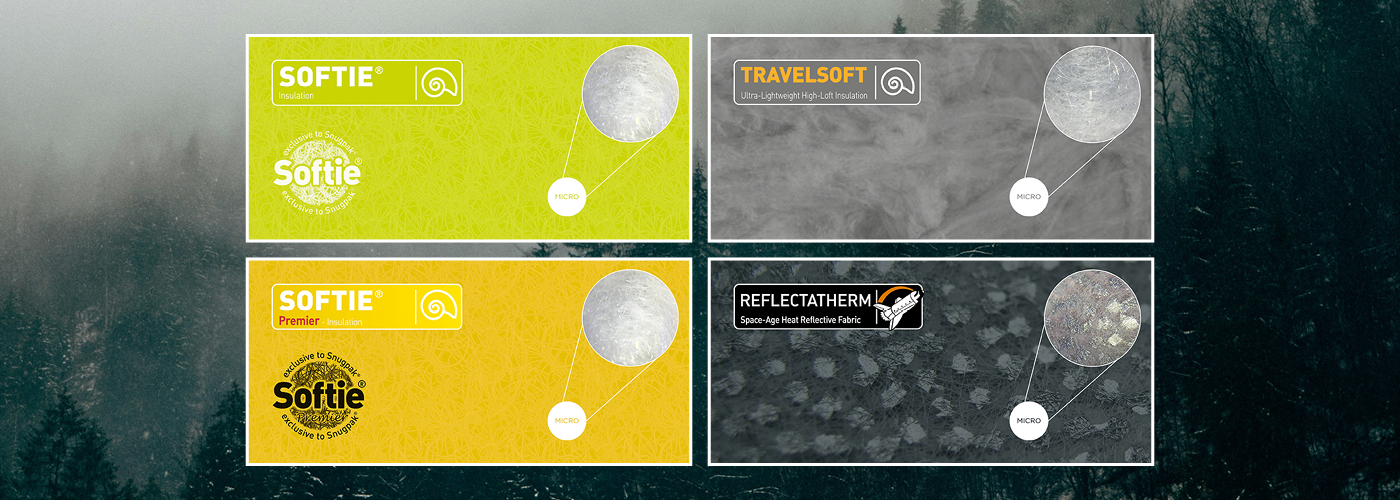
Understanding Insulation in Snugpak Products
Ever wondered why some sleeping bags keep you warmer than others? If you’re venturing into the great outdoors, the right insulation can often mean the difference between a cosy, restful night and a cold, uncomfortable one spent tossing and turning. Whether you’re camping in the woods, trekking through the mountains, or serving in the military, your gear’s insulation is crucial for staying warm and comfortable— and avoiding a downright miserable trip!
Here at Snugpak, we have a reputation for durable and reliable outdoor gear, many of which feature high-performance synthetic insulation. Understanding the different types of insulation used in Snugpak products can help you choose the right products to suit your needs and environment.
In this guide, we’ll compare the various synthetic insulation types found in Snugpak gear to help you choose the perfect products for your next adventure.
The Basics of Insulation
Insulation works by trapping air to reduce heat loss. The more efficient the insulation, the more warm air it retains, and the better it performs. In sleeping bags and outdoor gear, insulation helps maintain body temperature by limiting the amount of heat that’s transferred to the surrounding cold air.
For more information about insulation, check out our ‘Understanding Heat Loss, Insulation, and Hypothermia’ article.
Factors Affecting Insulation
|
Factor |
What It Means |
Effect On Insulation |
|
Material Type |
Type of fabric/fill used (wool, down, synthetics, etc.) |
High-performance materials trap more air and resist moisture. |
|
Fabric Thickness & Loft |
Amount of air trapped in the garment’s fibres (thickness and fluffiness) |
More loft means more trapped air, which means better insulation. |
|
Layering |
Wearing multiple layers (base, mid, outer) |
Layers trap air between them, improving overall insulation. |
|
Moisture |
Presence of sweat, rain, or condensation |
Wet clothes or sleeping bags lose heat fast. Some materials are better at retaining warmth even when wet. |
|
Wind Resistance |
Ability to block wind from penetrating the garment or sleeping bag. |
Windproof outer layers or wind-resistant sleeping bags help maintain warmth by preventing heat loss through wind. |
|
Compression |
When insulation is compressed (by tight gear, sitting, or carrying gear) |
Compressed insulation loses its air-trapping ability and becomes less effective. |
|
Design Features |
Includes cuffs, zippers, hoods, seams, and other features that help seal in heat. |
Proper sealing around arms, neck, and zippers helps minimise heat loss. |
Read our handy article on layering for more information on protecting yourself against adverse weather.
Snugpak Insulation Ratings
For many of our products, we assign a comfort rating and a low-temperature rating based on over 40 years of experience and customer feedback.
Comfort Rating. For sleeping bags, this assumes you’ll be sleeping lightly, clothed in a thermal base layer or pyjamas, on a quality sleeping mat inside a tent. At this temperature, most users should feel comfortable and get a good night’s sleep.
Low-Temperature Rating. This represents the lowest temperature at which the sleeping bag has been used by fit individuals with minimal discomfort.
We also provide these ratings for our insulated jackets to help you choose the right jacket for different temperatures or environments.
Examples of Snugpak Insulation Ratings:
-
Temperature Rating Comfort: -20°C / -4°F
-
Temperature Rating Low: -30°C / -22°F
-
Temperature Rating Comfort: 0°C / 32°F
-
Temperature Rating Low: -5°C / 23°F
-
Temperature Rating Comfort: -5°C / 23°F
-
Temperature Rating Low: -10°C / 14°
While our comfort and low-temperature ratings provide a reliable guide, real-world conditions can often feel colder, especially when wind chill is factored in. Understanding the ‘feels like’ temperature is just as important when preparing for extreme conditions.
Read our ‘Wind Chill & Evaporative Heat Loss’ guide for practical tips on trip planning, emergency prep, and protecting yourself from cold-related risks and emergencies.
Synthetic Insulation in Snugpak Products
At Snugpak, we use 4 main types of insulation, which we will break down below.
Softie®
Softie® is a synthetic (Polyester) filling used in sleeping bags like the Softie Elite WGTE and insulated jackets like Arrowhead WGTE. Made from fine yarns bonded with resins, it offers a soft, down-like feel. Unlike typical synthetic fills, Softie® uses staple yarns that mimic natural insulation, with processes like curling and crimping to create a random structure.
This gives it an advantage over standard insulation, which uses thick, bulky fibres. Softie®'s fine filament fibres increase loft and trap more warm air, all while maintaining the same weight as traditional insulation.
Features
-
Easy to wash
-
Retains heat when wet
-
Super-fine filaments
-
Natural soft feel
Softie® Premier
Softie® Premier is our best insulation, used in products like the Softie® 10 WGTE and the SJ Jacket Range. Made in Switzerland, it offers better warmth and loft for superior performance in colder climates. Building on our original Softie® insulation, Softie® Premier uses improved technology and resins, making it finer, softer, and more durable.
Features
-
High loft
-
Easy to wash
-
Retains heat when wet
-
Super-fine filaments
-
Natural soft feel
TravelSoft
TravelSoft insulation uses ultra-lightweight, high-loft fibres that compress easily. These fibres provide less bulk of fill yet are still able to perform very efficiently. The lightweight nature of TravelSoft fibres makes it the perfect fill for travel equipment like our Hammock Quilt, Jungle Blanket and Jungle Bag.
Features
-
High loft
-
Easy to wash
-
Retains heat when wet
-
Super-fine filaments
Reflectatherm
Reflectatherm is a metallised fabric that reflects heat and keeps you warm. It’s highly breathable, adds very little weight or bulk, and provides at least 15% extra warmth. Best of all, it’s undetectable to the touch in the sleeping bag or garment.
Often used alongside Softie® Premier insulation, Reflectatherm is featured in products like the Softie Antarctica WGTE and our Tactical Sleeping Bag Range.
Features
-
Specially coated with metallic dots, which help trap heat
-
Excellent weight-to-warmth ratio
-
The coating does not affect breathability
Choosing the Right Snugpak Products
When choosing your Snugpak gear, consider the conditions you’ll face—cold temperatures, humidity, and altitude—and match them with your expected activity level. If you’re trekking long distances, weight and packability matter. If you’re camping in damp climates, moisture resistance is key. And, of course, balance all of that with your budget.
Recommendations
-
For harsh winter expeditions: Try the Softie® Elite 5 Sleeping Bag and the SJ12 WGTE, both of which utilise Softie® Premier insulation for maximum warmth and performance in sub-zero temperatures.
-
For year-round versatility: The Softie® 3 sleeping bag and the Sleeka Elite Jacket offer reliable mid-level insulation with excellent packability.
-
For lightweight travel: Go for the Travelpak 2 Sleeping Bag or Travelpak Traveller, both designed with TravelSoft insulation to keep weight low without sacrificing comfort.
-
For added heat retention: Look for products incorporating Reflectatherm, like the Softie® Expansion Series, which combines reflective heat technology with soft, compressible insulation.
Care and Maintenance
To keep your Snugpak gear performing at its best, proper care is essential. Always follow the washing and drying guidelines for synthetic insulation found on our care instructions page. In general, use a gentle cycle with cool water and avoid harsh detergents or fabric softeners. Air-drying is recommended, but if you use a machine, use a low heat setting.
For long-term storage, make sure your gear is clean and fully dry before packing it away. Store in a loose, uncompressed state, such as in a large cotton sack, to maintain loft and insulation efficiency.
Regular maintenance not only extends the life of your product but also ensures it continues to perform when you need it most.
Adventure Done Right with Snugpak
Whether you’re facing Arctic conditions or just planning a spring hike, Snugpak has the right insulation to match your needs. Softie® Premier and Softie® offer dependable warmth for colder environments. TravelSoft delivers lightweight comfort for milder climates, and Reflectatherm adds that extra edge when heat retention is critical.
With the right Snugpak gear in your pack, you’ll be ready for whatever the outdoors throws your way. Get started today!

